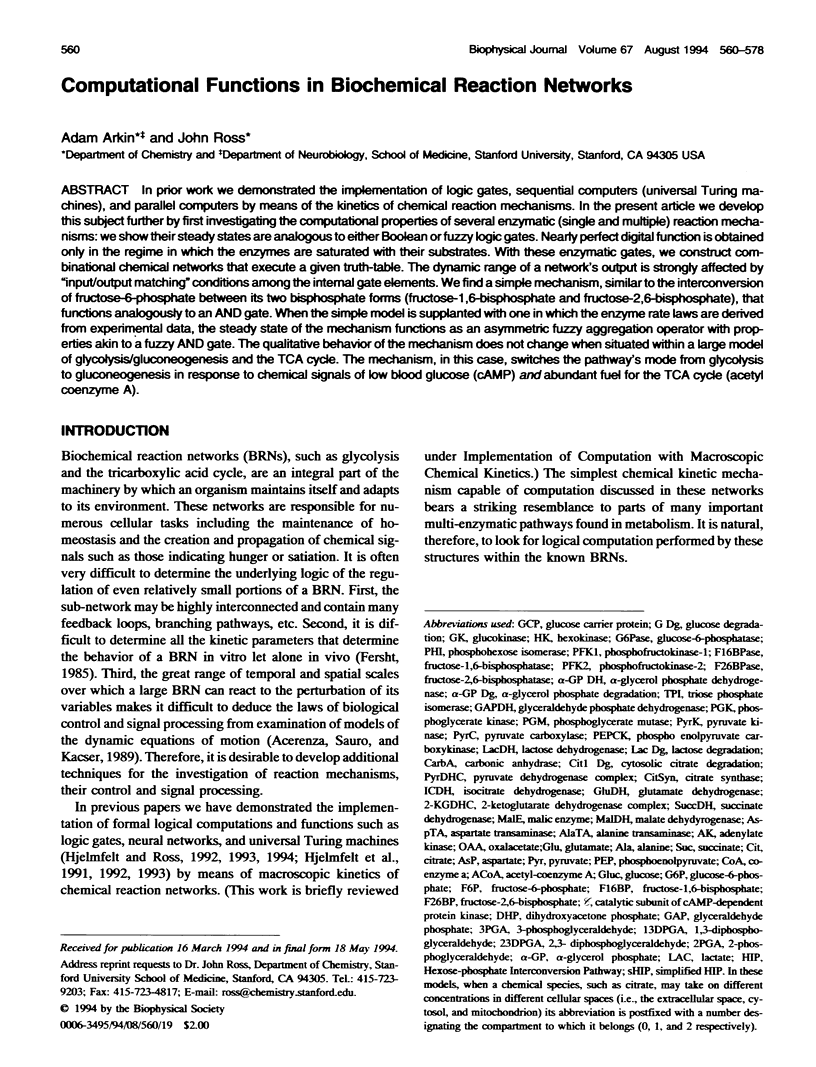Computational functions in biochemical reaction networks (original) (raw)
Abstract
In prior work we demonstrated the implementation of logic gates, sequential computers (universal Turing machines), and parallel computers by means of the kinetics of chemical reaction mechanisms. In the present article we develop this subject further by first investigating the computational properties of several enzymatic (single and multiple) reaction mechanisms: we show their steady states are analogous to either Boolean or fuzzy logic gates. Nearly perfect digital function is obtained only in the regime in which the enzymes are saturated with their substrates. With these enzymatic gates, we construct combinational chemical networks that execute a given truth-table. The dynamic range of a network's output is strongly affected by "input/output matching" conditions among the internal gate elements. We find a simple mechanism, similar to the interconversion of fructose-6-phosphate between its two bisphosphate forms (fructose-1,6-bisphosphate and fructose-2,6-bisphosphate), that functions analogously to an AND gate. When the simple model is supplanted with one in which the enzyme rate laws are derived from experimental data, the steady state of the mechanism functions as an asymmetric fuzzy aggregation operator with properties akin to a fuzzy AND gate. The qualitative behavior of the mechanism does not change when situated within a large model of glycolysis/gluconeogenesis and the TCA cycle. The mechanism, in this case, switches the pathway's mode from glycolysis to gluconeogenesis in response to chemical signals of low blood glucose (cAMP) and abundant fuel for the TCA cycle (acetyl coenzyme A).

Images in this article
Selected References
These references are in PubMed. This may not be the complete list of references from this article.
- Acerenza L., Sauro H. M., Kacser H. Control analysis of time-dependent metabolic systems. J Theor Biol. 1989 Apr 20;137(4):423–444. doi: 10.1016/s0022-5193(89)80038-4. [DOI] [PubMed] [Google Scholar]
- Achs M. J., Anderson J. H., Garfinkel D. Gluconeogenesis in rat liver cytosol. I. Computer analysis of experimental data. Comput Biomed Res. 1971 Apr;4(1):65–106. doi: 10.1016/0010-4809(71)90047-4. [DOI] [PubMed] [Google Scholar]
- Achs M. J., Garfinkel D. Computer simulation of energy metabolism in anoxic perfused rat heart. Am J Physiol. 1977 May;232(5):R164–R174. doi: 10.1152/ajpregu.1977.232.5.R164. [DOI] [PubMed] [Google Scholar]
- Hjelmfelt A., Schneider F. W., Ross J. Pattern recognition in coupled chemical kinetic systems. Science. 1993 Apr 16;260(5106):335–337. doi: 10.1126/science.260.5106.335. [DOI] [PubMed] [Google Scholar]
- Hjelmfelt A., Weinberger E. D., Ross J. Chemical implementation of finite-state machines. Proc Natl Acad Sci U S A. 1992 Jan 1;89(1):383–387. doi: 10.1073/pnas.89.1.383. [DOI] [PMC free article] [PubMed] [Google Scholar]